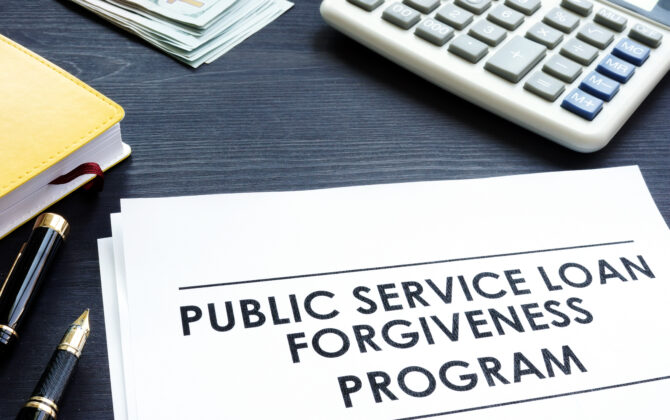What began as a pandemic-related response to assist student loan borrowers in March 2020, resulted in federal student loan payments and interest being paused for over three years. After eight extensions, the US Department of Education put an end to the pause on student loan payments. Interest resumed as of September 1, 2023, and payments resumed as of October 2023. Additionally, after months of uncertainty, the Supreme Court finally struck down the student loan debt relief plan that President Biden proposed in August 2022 and would have forgiven up to $20,000 for low- and middle-income borrowers.
Both of these major developments in the world of federal student loans have left many borrowers wondering how to quickly recalibrate their budgets to make monthly payments again, while recent graduates may be wondering how to set up student loan payment for the first time.
However, many borrowers will have other potential pathways to full or partial forgiveness available to them, regardless of their student loan debt amount and employment type. “Even with the SCOTUS decision, there are still other paths to federal student loan forgiveness through government programs such as Public Service Loan Forgiveness (PSLF) and Income-driven Repayment (IDR),” said Chris Walters, head of GradFin.1
“IDR – which calculates your monthly payment amount based on factors like adjusted gross income and family size – will be the path forward for most borrowers, and can forgive your remaining student loan balance after 20 or 25 years of repayment.”
Let’s take a closer look at how borrowers can prepare, the latest status of federal student loan forgiveness programs, and how to start saving for the new financial reality ahead.
Check your loan types, what you owe, and what has changed
Make sure you understand your current loans, including the type of federal student loans you have, your current balance, the type of plan, and who your current loan servicer is – since this may have changed. Be sure to update your contact information on your loan servicer’s profile and in your StudentAid.gov profile. Also keep in mind, if you had enrolled in any automatic debit payments, may need to contact your new loan servicer directly to re-enroll or set up autopay for the first time.
Understand your repayment plan and payment schedule
After you’ve gotten up-to-date on how much you owe and any changes related to your account, you can determine your next steps. While the landscape of options may seem complicated, you’ll want to refamiliarize yourself with your current repayment plan to make sure you’re enrolled in the right plan for your current circumstances. Are you enrolled in a Standard Repayment Plan or are you eligible for an income-driven repayment (IDR) plan? For many borrowers, an IDR plan could make your monthly payments more affordable, depending on your income and family size; learn more below.
Our student loan specialists can also help you evaluate your IDR plan options based on your personal circumstances. Learn more here.
Changes to student loan servicers
Since 2020, there have been significant changes to loan servicers that will potentially impact borrowers. First, make sure you know your current loan servicer, since this may have changed during the pause. According to a recent Consumer Financial Protection Bureau (CFPB) report, over 40% of student loan borrowers will have a different loan servicer than the one they had prior to the payment pause. To confirm your current student loan servicer, you can log in to your studentaid.gov profile, visit your account dashboard and scroll down to the “My Loan Servicers” section.
Now, let’s look at how IDR plans could help you manage your monthly payments and some proposed changes that could make an IDR plan even more affordable for borrowers.
Explore Income-driven Repayment (IDR) Plans
If you’re having difficulty making your monthly student loan payments, then income-driven repayment (IDR) plans may be a good option to explore. The IDR program consists of multiple plans that provide federal borrowers with options other than forbearance:
IDR Comparison Chart
|
Applications for SAVE, other IDR plans, and loan consolidation are available on http://studentaid.gov. You can also submit a PDF application to your loan servicer by uploading it to your servicer’s website, or mailing it to them. Expect a delay in processing times. The Education Department recommends checking its website for updates – there is no processing time estimate available. |
|
Plan |
Monthly Payments |
Repayment Period |
Status |
|
SAVE (formerly REPAYE) |
- 5% of discretionary income for Undergraduate Loans
- 10% of discretionary income for Graduate Loans
- Weighted average for borrowers who have both
|
- 10 years for low-balance borrowers (less than $12,000)
- 20 years for only undergraduate loans
- 25 years for any Graduate Loans
|
Replaced REPAYE |
|
Income-Based Repayment (IBR) |
- 10-15% of your discretionary income (and your spouse’s if filing jointly)
- Never more than federal 10-year Standard Repayment Plan amount
|
20-25 years, depending on when you become a new borrower |
Remains available but borrowers cannot select plan after 60 payments on REPAYE that occur on/after July 1, 2024 |
|
Income-Contingent Repayment (ICR) |
The lesser of the following: - 20% of your discretionary income or
- What you would pay on a repayment plan with a fixed payment over the course of 12 years, adjusted according to your income
|
25 years |
Not accepting enrollments for current students; only available to future borrowers with consolidated Parent PLUS loans |
|
Pay as You Earn (PAYE) |
- 10% of your discretionary income (and your spouse’s if filing jointly)
- Never more than federal 10-year Standard Repayment Plan amount
|
20 years |
Not accepting new enrollments |
IDR plans use various formulas to calculate your monthly payments based on your adjusted gross income and family size, and also provides a path to eventual forgiveness. Many federal student loan borrowers will likely qualify for more than one type of IDR plan as well. For more details on IDR plans, visit studentaid.gov or check out the pros and cons of IDR plans here. Or, learn about how to apply for student loan forgiveness here.
Challenges to SAVE
Multiple legal challenges made by states to the Saving on A Valuable Education (SAVE) plan could impact implementation of key aspects of the plan. For the most up-to-date developments, visit studentaid.gov.
Public Service Loan Forgiveness (PSLF) program
The Public Service Loan Forgiveness (PSLF) program is available to borrowers employed by government entities (federal, state or local), or qualifying not-for-profit organizations, and allows them to qualify for student loan forgiveness after ten years of qualifying income-driven payments, entirely tax-free.
The qualifications for PSLF include:
Qualifying employment
Federal Direct Loans
120 qualifying payments
Qualifying employment
You must be employed full-time at a US government organization at any level (federal, state, local, or tribal) – including US military service – or a qualifying nonprofit organization. Full-time employment is currently defined as a minimum of 30 hours per week.
Federal Direct Loans
Borrowers should have Federal Direct Loans. Or, borrowers with other types of federal loans, such as FFEL, Perkins, or HEAL loans, may be able to apply for a Direct Consolidation Loan. Learn more at studentaid.gov/consolidation.
120 qualifying payments
Participants will need to make 120 on-time qualifying payments over ten years to qualify for PSLF forgiveness of any remaining balance. These payments do not need to be consecutive, so if you worked in the private sector for a period of time and then returned to public service you could pick up where you left off.
To find out if you can qualify and learn how to stay on track for PSLF, talk to a student loan specialist today.
Review and prepare your budget
If your bills have changed or increased since the payment pause began, you’re not alone. According to a March 2023 report by the Consumer Financial Protection Bureau’s (CFPB), 50% of all student loan borrowers expected to return to repayment have scheduled monthly payments for non-student loan or non-mortgage debts that are at least 10 percent higher than they were before the payment pause began. While these economic challenges may seem daunting, with the right preparation and budgeting, you can still create a path to manage your student loans.
To prepare, you’ll want to review your current budget as you get ready to resume monthly payments. It may be a good time to track and review your overall monthly budget and see if there is any non-essential spending you can reduce, such as unused subscriptions. We recommend the 50-30-20 budget method for a quick view of your expenses.
You could consider transferring your expected monthly payment to a savings account, which will also help you build up an additional cushion. While higher interest rates are leading to increased costs in other areas, a high yield savings account allows you to benefit from today’s higher rates. See how to make the most of your savings with competitive rates on a High Yield Savings account from Laurel Road, with zero costs to open and no minimum balance required.
Get help from a student loan specialist
If the past few years are any indication, the student loan repayment environment will continue to evolve and be a topic of debate. Additionally, recent student debt relief announcements from the Biden administration mean borrowers may have more questions than answers about their student loan options.
If you’re looking to understand your repayment plan options, want to change to an IDR plan, or are considering pursuing student loan forgiveness, you can reach out to one of our student loan specialists to create a personalized plan. Our GradFin team can help you understand your eligibility, determine which plan is right for you, and estimate your potential forgiveness if you’re eligible.
Our specialists can evaluate your personal circumstances and repayment options, and keep you updated with the latest federal program updates, including any new repayment or forgiveness changes. Get a head-start to understand your options today with a free 30-minute consultation.
No matter what your path is, it’s important to make sure you understand all your current options, including what has changed when it comes to your loans or loan servicer. Now is always a good time to evaluate your budget and advance your financial future.







